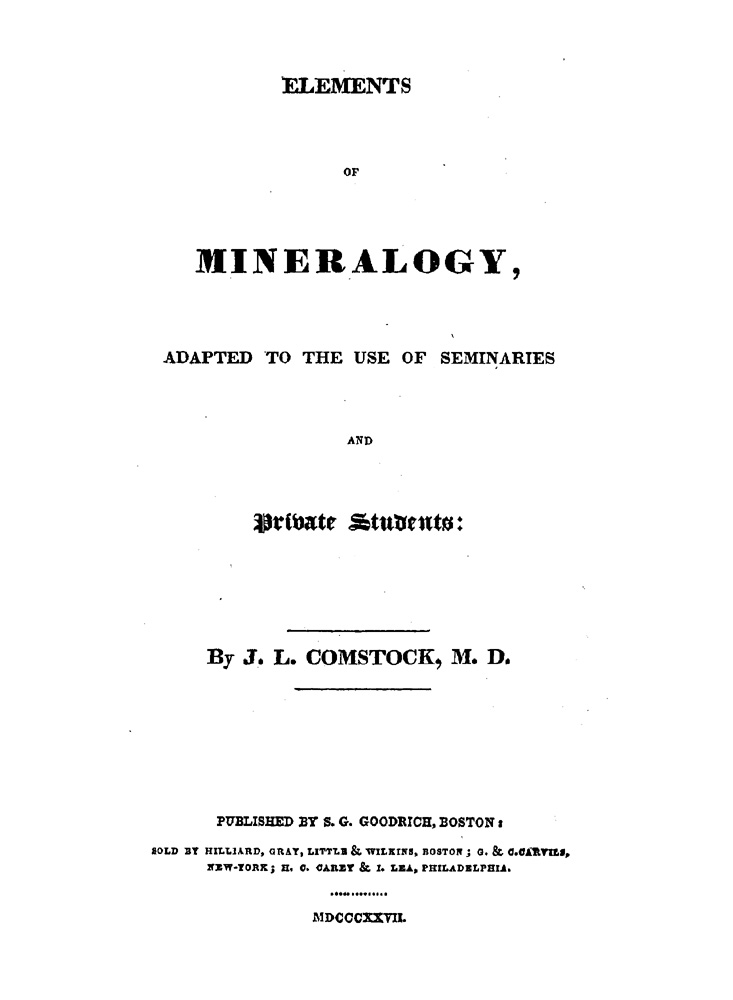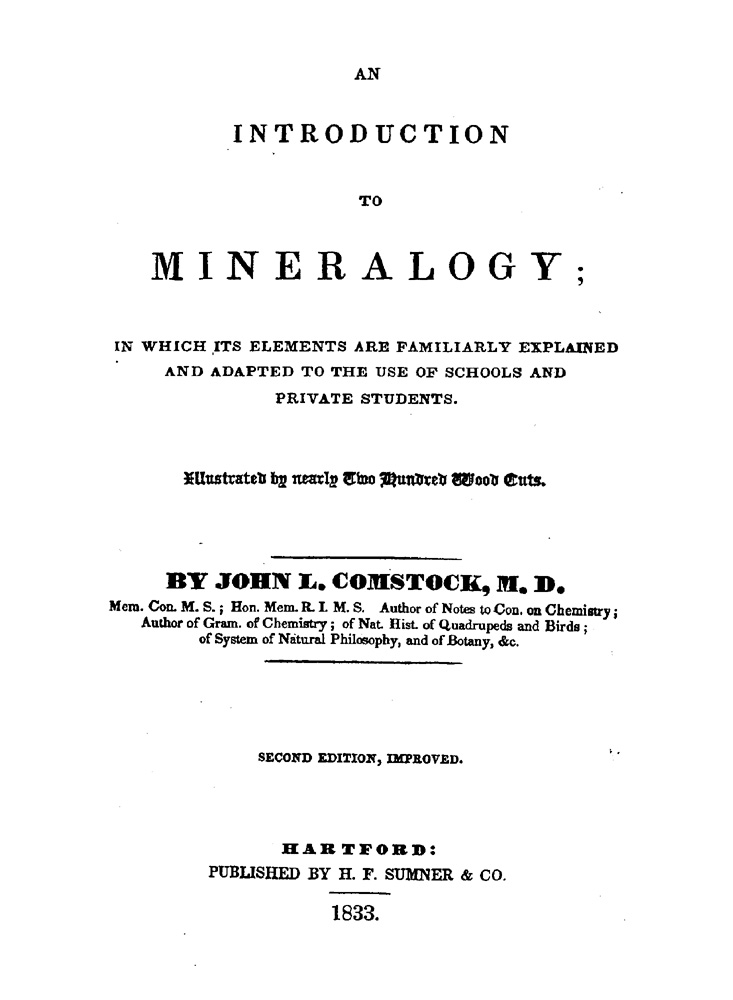COMSTOCK, John Lee.
(1789 – 1858)
Little is known of his life until the war of 1812-15. Then he worked as a surgeon in the army and thereafter added M.D. to his name. Comstock was a self educated man, and upon his discharge from military service, he returned to Connecticut where he lived the remainder of his life in Hartford. As a means of livelihood, Comstock prepared texts for the use of schools on a large spectrum of subjects, including chemistry, mineralogy, botany, natural history, geography, and physiology. His Natural Philosophy became a standard, and its world wide sales approached nearly a million copies-evenmore remarkable in the nineteenth century, than it is today. It is recorded that Comstock possessed a good mechanical skill that allowed him to construct whatever apparatus might be required in his various studies, and being an able draftsman, create the illustrations used in his numerous books.
Biographical references: ABA. • American Chemists & Chemical Engineers: 2, 46-7 [by W.D. Williams]. • Appleton Cyclopedia of American Biography. • Drake, Dictionary of American Biography, 1872: 211. • Herringshaw's National Library of American Biography. • National Cyclopedia of American Biography: 1888, ??. • Poggendorff: 3, 293. • WBI.

1. English, 1827 [First edition].
Elements | Of | Mineralogy, | Adapted To The Use Of Seminaries | And | Private Students: | [rule] | By J.L. Comstock, M.D. | [rule] | Published By S.G. Goodrich, Boston: | Sold By Hilliard, Gray, Little & Wilkins, Boston; G. & C. Carvils, | New York; H.C. Carey & L. Lea, Philadelphia. | ............. | MDCCCXXVII.
8°: [i]-lxxvi, [1]-338, [2] p., illus. Page size: 221 x 130 mm.
Contents: [i-ii], Title page, verso "S.G. Goodrich, Publisher, Boston, ..."; [iii]-iv, "Advertisement."-dated Hartford, January 1st, 1826.; [vii]-xi, "Preliminary Explanations."; [x], "Explanations."; [xi]-li, "Introduction."; [lii]-lxii, "Explanation Of Terms, &c. | Commonly used in Mineralogical Descriptions."; [lxiii]-lxvii, "A Table, | Exhibiting the angular admeasurements of crystals by the Reflecting | Goniometer, according to Phillips."; [lxviii]-lxxvi, "Tabular Arrangement."; [1]-298, Text.; [299]-316, "Appendix." [=new minerals].; [317]-320, "Addenda."; [321]-338, "Index."; [1 pg], "Errata."; [1 pg], Blank.
Very scarce. An 1826 a notice in the American Journal of Scienceannounced the pending publication of A Manual of Mineralogy by J.L. Comstock in which "the science is illustrated by cuts in the text, and a considerable number of colored engravings ..." Since no copies are recorded in the libraries of the United States or Great Britain, this particular title would seem never to have been published. In the next year, however, Comstock's Elements of Mineralogy did appear, and although containing no plates, colored or plain, the work is illustrated throughout with woodcuts. Elements would therefore appear to be the rechristened Manual announced in 1826.
Elements is a volume that was designed as a less expensive and weighty alternative to Parker Cleaveland's landmark Treatise. It was intended to be used as a textbook in the schools and higher seminars in America, which were instructing students in mineralogy. Therefore, Comstock begins the volume with the basics, including preliminary definitions of mineralogy and geology and the characters of minerals, and continues into slightly expanded definitions of external characters, color, luster, cleavage, transparency, etc. The greater majority of the volume is then given over to the describing of specific mineral species. Comstock described his Elements in an advertisement as a volume "... of such a size as to come within the means of almost everyone ... and if well done, [it] would facilitate the progress of science in our country." It is well worth noting that Elements was not kindly received in its only review. Here the anonymous writer berates Comstock for appearing to know little or nothing of the science of mineralogy and its current state of advancement in America. The review ends with a classic poison pen: "This work is as full of errors of the press, as of the pen, and so far from facilitating the progress of science, carries us back something like ten years."
Another issue, 1832: Elements of Mineralogy. Boston?, 1832. 8°: 343, [1] p., illus.
Another issue, 1841: Elements of Mineralogy. Boston?, 1841. 8°: 369, [1] p., illus.
Bibliographical references: American Journal of Science: 1st series, 10 (1826), 400 [book notice]. • NUC. • Roller & Goodman, Catalogue, 1976: 1, 245.
Introduction
2. English, 1832 [First edition].
An | Introduction | To | Mineralogy; | Adapted To The Use Of Schools, | And Private Students. | Illustrated By Nearly Two Hundred Wood Cuts. | [rule] | By John L. Comstock, M.D. | [rule] | Hartford: | Published by B.B. Barber. | [rule] | 1832.
12°: 343 p., illus.
Very scarce. Introduction to Mineralogy is written in a similar though distinct style from its forebearer, Elements. The first noticeable difference is that the woodcuts are of a cruder, less refined character; however, the cuts do depict the same subjects as did Elements. Unlike the eariler work though, Introduction to Mineralogy enjoyed for many years a broad popularity as a textbook and fieldguide, which also created its peculiar bibliography. Oddly, Introduction to Mineralogy was never reviewed or even noticed in the journals of the period. This fact undoubtedly contributed to its success as it contains many flaws. In addition, no reference to either of Comstock's works appears in any other American mineralogy. Yet, the legacy of these textbooks is that they were usually the first mineralogical work that exposed American students to the science, and during the gold rush, Comstock's Introduction was a title carried west by many a forty-niner.

3. English, 1832 [2nd edition].
An | Introduction | To | Mineralogy; | Adapted To The Use Of Schools, | And Private Students. | Illustrated By Nearly Two Hundred Wood Cuts. | [rule] | By John L. Comstock, M.D. | [rule] | Second Edition, Improved. | [rule] | Hartford: | Published by B.B. Barber. | [rule] | 1832.
12°: [4], [3]-143 (i.e., 343), [1] blank p., illus., index. Page 343 misnumbered 143.
Very scarce. This second edition of Introduction appeared the same year as the first, 1832, and contains according to its Advertisement, "more that forty new cuts" and corrections throughout most parts of the volume. This second edition was issued several times with either a new year or new publisher on the title page; however, the pagination of the volume remained the same. Other issues of this edition appeared in:
Bibliographical references: Hazen & Hazen, American Geological Literature, 1980: no. 2510.
4. English, 1836 [3rd edition].
An | Introduction | To | Mineralogy; | Adapted To The Use Of Schools, | And Private Students. | Illustrated By Nearly Two Hundred Wood Cuts. | [rule] | By John L. Comstock, M.D. | [rule] | Third Edition, Improved.| New York: | Published By Robinson, Pratt, & Co. | [rule] | 1836.
12°: 1-306 315; 185l.; [1]-369, [1] p., 186 illus., index.
Contents: [1-2], Title page, verso copyright notice; [3], "Advertisement to the second edition"; [4], "Advertisement to the third edition"; [5]-10, "Index"; [11]-342, "Introduction to mineralogy"; [343]-360, "Appendix. Containing the description of minerals not embraced in the body of the work"; [361]-366, "Explanation of terms, & c., commonly used in mineralogical descriptions"; [367]-369, "A table, exhibiting the angular admeasurements of crystals by the Reflecting Goniometer, according to Phillips."; [1 pg], Blank.
Scarce. This text is divided into two parts. The first is an introduction to mineralogical science. It covers crystallography, predominate forms of crystals, mechanical division of crystal angles, primitive forms, most common forms, double refraction, colors of minerals, luster, hardness, electricity, specific gravity, and chemistry. The second is a descriptive mineralogy which emphasises localities in the United States. Closing the work are an explanation of terms, and a table of goniometeric measurements according to William Phillips. This is the third, and last revision of the text by the author. Comstock updated the book by additions of new species and an appendix "containing the description of minerals not embraced in the body of the work." Locality information was also updated. Although no other additions or corrections were ever made to the text again, this book was issued over and over until the middle of the ninteenth century. After the eleventh issue, the publisher, perhaps sensing buyer reluctance, replaced the words "Third edition, improved" on the title page, with an edition note [perhaps noting the edition of the title page itself!]. The twenty-sixth and probably final "edition" appeared in 1852.
Bibliographical references: Hazen & Hazen, American Geological Literature, 1980: no. 2511. • NUC: 118, 326-27 [NC 0603823].
.